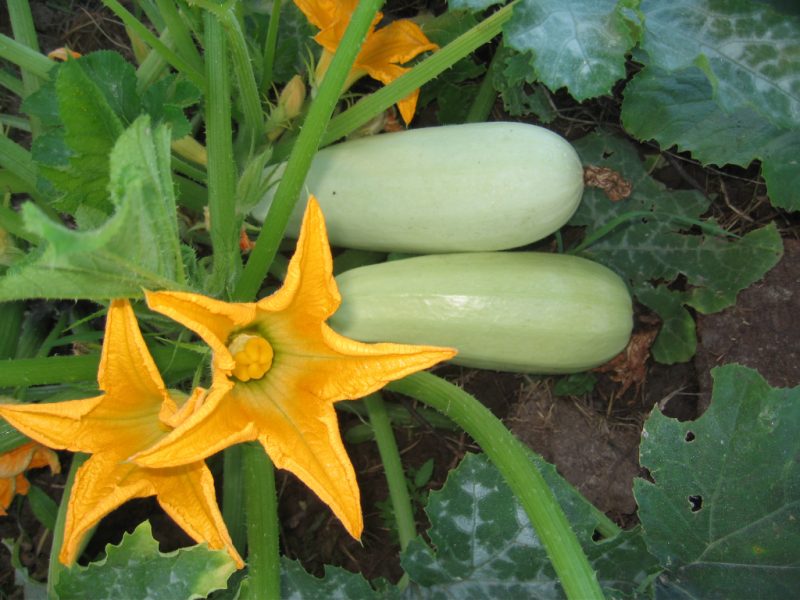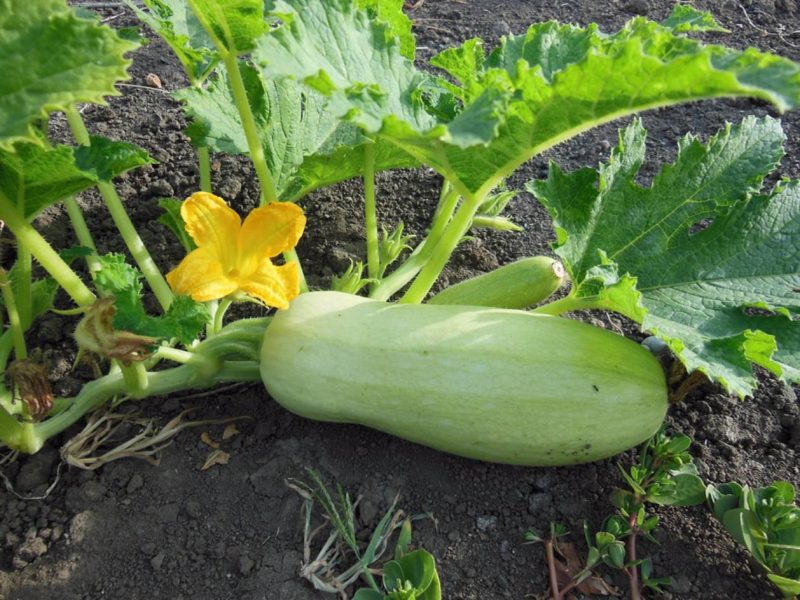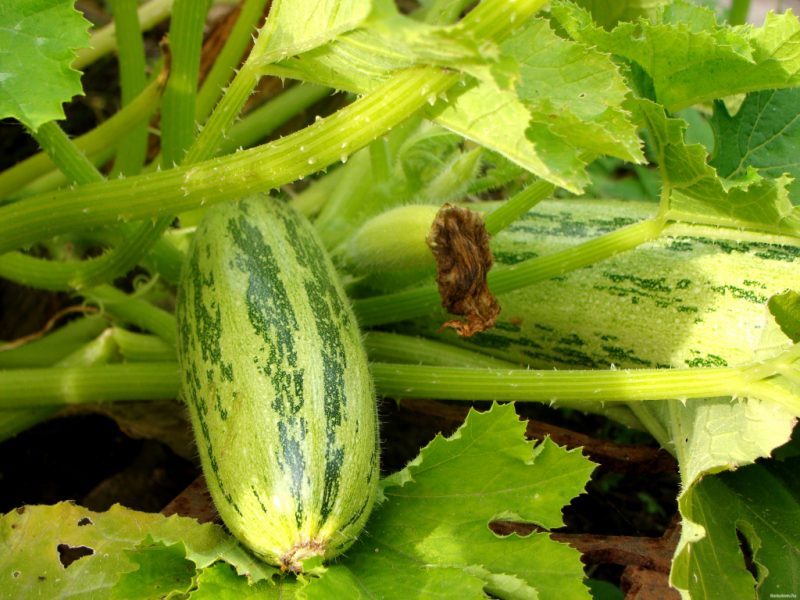Among the variety of vegetables, in courtyards you can find zucchini, cultivation and care in the open field does not take much time and unnecessary trouble. With the slightest care for a healthy vegetable, in season he will please the owner with a rich harvest of vitamin fruits.
Material Content:
Varieties of zucchini for open ground
The cultivation of zucchini depends on the main condition: you need to choose a suitable variety of vegetables that are suitable for seasonal conditions and soil composition in order to get a rich harvest.

The most common varieties of zucchini for open ground are:
- Masha. This variety is resistant to diseases and pests. It can tolerate any climatic conditions. Fruits weighing up to 4 kg have a greenish color.
- Belogor. Early ripe variety, can tolerate drought and rainy weather. Elongated cylindrical fruits. Weight reaches not more than 1.5 kg.
- Apollo. Mid-season variety capable of withstanding any weather conditions. Fruits are elongated, light with a yellow tinge, weighing up to 4 kg high yield.
- Gribovsky. A high-yielding variety that requires a lot of space for planting, due to the huge bushes. Fruits are spherical, white in color, with tasty and soft pulp. It is well stored for a long time, easily tolerate transportation.
- Spaghetti. Early ripening variety, distinguished by its pulp. After heat treatment, the pulp of the fetus is divided into thin fibers. During growth, it is necessary to direct the lashes in one direction so that they do not creep over the entire area.
Each gardener independently chooses the type and variety of vegetables that is suitable for seasonal and weather conditions for the region.
Basic requirements for growing

To achieve a high crop of vegetable marrows in the open ground, it is necessary to consider and fulfill some requirements:
- Carefully approach the choice of varieties and hybrids, depending on weather conditions, for high fruiting.
- Choose a suitable place for planting with adequate lighting and nutrient composition of the soil.
- Perform timely care, treatment from pests and diseases.
Zucchini is an unpretentious plant, for a high harvest they have their basic requirements.
Growing seedlings from seeds
In order to get ripe fruits of vegetables earlier, it is better to grow seedlings on your own from seeds, and after that ready seedlings to plant on beds.
To grow seedlings, you must follow the instructions:
- Pre-soak the seeds in solution by mixing 1 tablespoon of ash with 1 liter of water, and leave for 3 days.
- Prepare the composition of the soil by mixing from equal parts: turf land, humus, peat, sand and sawdust.
- Distribute the prepared soil into separate pots and shed with a weak solution of potassium permanganate.
- Deepen the swollen seeds into the ground by 1-1.5 cm, covering the top with a plastic bag, forming the effect of a greenhouse.
- After the first germs appear, remove the packets and place the pots in a cool place.
- Watering, as the soil dries, until the plant has to be planted in open ground. The optimum temperature will be 20 degrees.
Important! When growing zucchini in seedlings, the fruits will not be able to survive for a long time. For winter storage, it is better to plant finished seeds immediately in an open place.
Planting zucchini in the open ground

Planting seedlings of vegetables in open ground is allowed after a month, as the sprouts get stronger, and the first frosts pass. Before planting seedlings, prepare special beds. Dig the earth, fertilize and spill boiling water.
How and when to plant?
Planting zucchini can begin in late May, early June. It all depends on the weather. You can plant several batches, with a weekly break. To keep vegetables as long as possible. Land in the evening, or early in the morning in cloudy weather. You should not choose a site close to planting pumpkins.
To plant the finished seedlings, you must follow these steps:
- At the required site, prepare planting beds. Dig in the recesses on them, adhering to the distance between the seedlings of 30-40 cm. The distance between the beds should be at least half a meter.
- Put a certain amount of humus and ash in each hole.
- Carefully remove the seedling from the pot, place it in the pit, to the lower leaves. Use your fingers to compact the ground and water it.
Planting seedlings must be carefully, together with an earthen lump. If seedlings grew in a peat pot, deepen them into the ground with it.
What can I plant?
To avoid diseases and damage to cultivated plants, choose a place under the beds every year. It is impossible to plant zucchini every year in one area. It is necessary to observe a break of 3 years. And also choose a place near the pumpkin. Between the beds and rows of planted vegetables it is allowed to plant onions and garlic. Their harvest is collected until the moment when the vegetable starts its whips.

To get a good harvest, it is better to plant vegetables in the ground, where the following crops grew:
- onion garlic;
- legumes;
- eggplant;
- cabbage;
- bean plants.
It is not recommended to plant zucchini with gourds. Both plants require beneficial substances, they will be exposed to one disease.
Soil preparation and location
Planting zucchini should be done in a well-lit place, protected from the winds.Greater attention must be paid to the composition of the soil. Vegetable culture prefers fertile and loose soil. The site begins to be prepared in the fall.

To do this, do the following:
- The necessary area is freed from the remains of vegetation, weeds.
- Dig up soil, up to 30 cm deep.
- Nutrients from compost and superphosphate are added to loose soil.
- With the onset of the spring period, the site is loosened and saltpeter is introduced.
Important! Suitable places for sowing are areas with plenty of sunlight. Productivity depends on this condition.
Outdoor Care
To achieve maximum yield, it is necessary to timely care for the plant.

It consists of:
- watering, irrigation;
- timely top dressing;
- weeding from weeds;
- loosening the soil.
Additionally, during the flowering period, if there are no bees, it is necessary to independently engage in pollination of the plant.
Watering, fertilizing and fertilizing
Watering should be carried out daily, early in the morning or in the evening, after sunset. To do this, take clean, settled water, warmed up in the sun. It is poured neatly from the watering can under the root so as not to wash the plant. After a month, when the leaves cover the earth, watering is reduced to 2 times a week. In hot summer time, irrigate squash crops daily.
During growth, fertilizers must be applied. The first top dressing is performed during the increase in green mass of mullein. It is bred in water, insisted and watered each bush under the root. The second top dressing is necessary during the flowering period. A certain amount of ash and superphosphate is bred in clean, settled water. Then the resulting solution is watered. The last fertilizer application should be carried out during the period when the fruits ripen. You can make manure, wood ash.
Zucchini processing
To prevent plants, they carry out activities that protect the bushes from pests and possible diseases. Processing vegetables can be done with tank mixtures, which consist of fungicides containing copper and insecticidal preparations. You can start the processing process after a week, after planting seedlings in open ground.

It is also recommended to process the seed so that the adult plant is less likely to be affected by disease.
Diseases, pests and control methods
Zucchini can undergo various diseases, regardless of preventive treatments.

The most common diseases of a vegetable crop are:
- Powdery mildew manifests itself in the form of bright spots on the leaves of the plant. Treatment of the bush with gray powder will help get rid of it. It is produced twice, after a week.
- Peronosporosis can be seen on the leaves in the form of light spots of a pale green color or yellow. To prevent this disease, the seeds are pre-soaked in a solution of potassium permanganate. In control measures, the bushes are sprayed with Bordeaux fluid.
- Bacteriosis acts as a spotting on the foliage and deformation of the fruit. In preventive measures, seed treatment and irrigation with Bordeaux fluid are necessary.
- Gray rot occurs when there is an excess of moisture in rainy weather. To get rid of it, you must immediately remove all affected parts. After spraying the bushes with a solution of urea or copper sulfate.
In addition to diseases on plants, you can find insect pests. To get rid of them, it is necessary to timely spray with fungicides.

Famous pests are:
- Gourd aphids. Eliminate the insect will help irrigation with a solution of laundry soap, karbofos, or sulfur.
- Spider mite eliminated if the plant is sprayed with a soap solution or sulfur solution.
- Whitefly With this insect, it is necessary to wash it off the leaves with a sponge and a soap solution.
Important! To prevent the occurrence of problems, it is necessary in the autumn to dig the earth and treat it with fungicides. Since some insect larvae winter easily in the soil.
Harvesting and storage
Varieties of zucchini are harvested at different times, due to the different ripening periods. The main condition for the collection is not to miss the time of maturity of the fetus so that it does not lose its taste. Overripe fruits cannot be left, this leads to a delay in the formation of new crops. They are removed as they reach removable maturity 1-2 times a week. Maturity can be determined by its appearance, or by touch. In a mature fetus, the peel becomes harder and a characteristic pattern with a bright color is expressed. Larger crops are inferior to smaller ones in taste.

To preserve the harvest for a long time, it is necessary to consider the following nuances:
- The fruit is cut with a sharp knife so that a long stalk remains.
- Fruits are placed in a dry room with constant air circulation.
- Put vegetables in wooden boxes so that they do not touch each other.
- Avoid storing vegetables in plastic bags to avoid decay.
In order to receive nutritious vitamins and minerals during the winter time, it is necessary to carry out comprehensive care of the vegetable crop. With timely processing and implementation of agricultural technology, they will please with a rich harvest.












